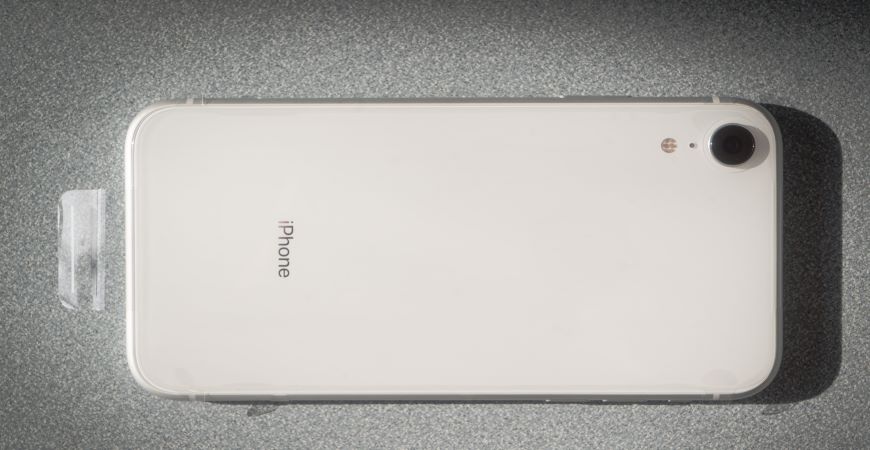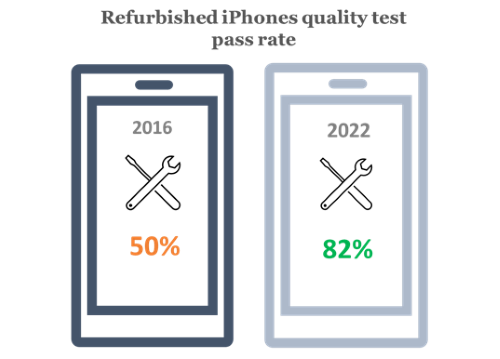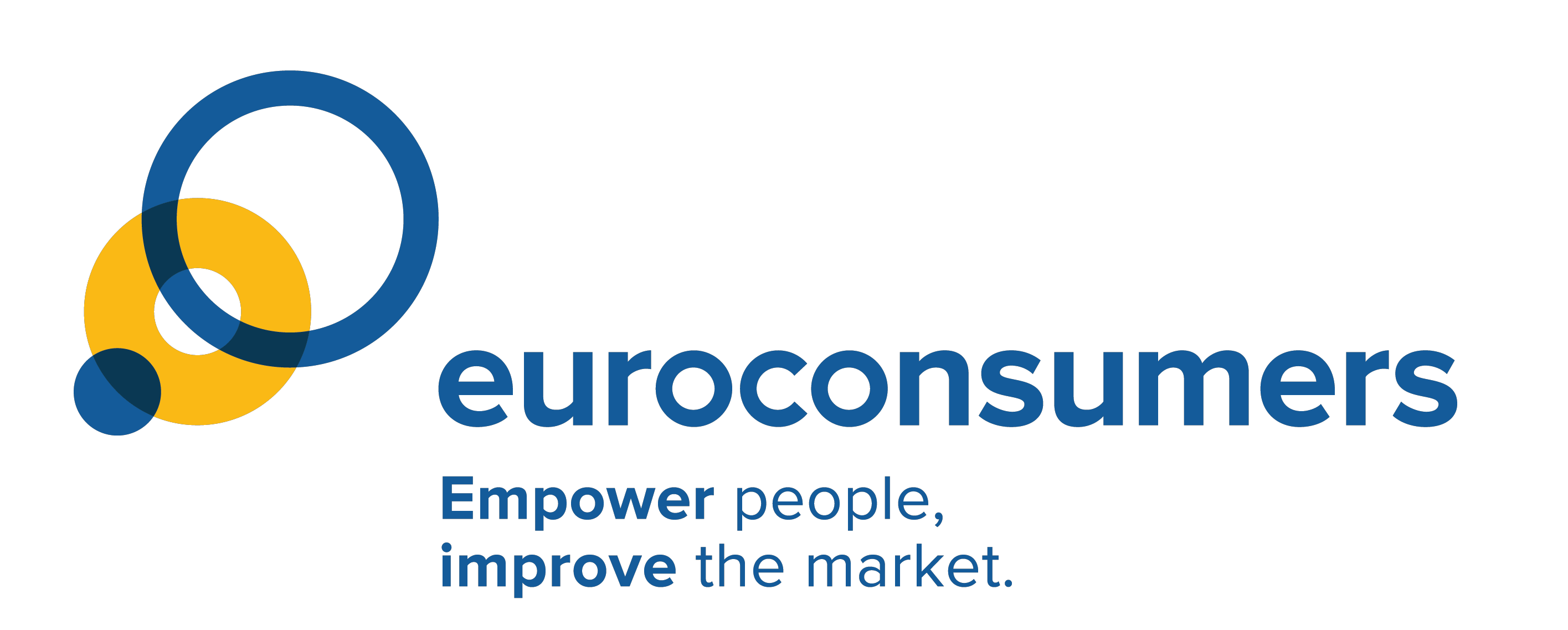This website uses cookies so that we can provide you with the best user experience possible. Cookie information is stored in your browser and performs functions such as recognising you when you return to our website and helping our team to understand which sections of the website you find most interesting and useful.
Refurbished iphones are getting better and better

With new iPhones costing upwards of €800, opting for a nearly new model is becoming increasingly popular. Consumers are weary of upgrading to every latest version especially when there aren’t significant innovations.
Environmental considerations are also a big pull – mass production of electronic devices puts a strain on the environment and waste systems.
On the supply side, the market for refurbished phones has also developed, with manufacturers and major retailers providing a wide range of quality graded pre-owned devices.
Although figures are hard to find, it does appear that confidence in refurbished phones is growing. In a 2021 consumer survey 65% of respondents said they felt confident buying refurbished smartphones, up 30% from 2019.
What is a refurbished smartphone?
Generally, refurbished phones are either handsets that have been returned due to a fault and repaired for resale, or devices that customers returned because they changed their mind in the cooling off period of their contract. On the other hand, ‘used’ smartphones is a much broader category which more often refers to well used phones being sold on by private sellers.
Is the quality of refurbished iPhones improving?
Is consumer confidence in the refurbished smartphone market well placed? Before being put on back sale, refurbished phones should have been thoroughly checked and tested to ensure they’re in full working order. Nevertheless, it’s difficult for buyers to know the exact state and quality of the device they are buying.
In the past, consumers have ended up disappointed, as was evidenced by our member Test-Aankoop/Test-Achat’s test of refurbished iphones in 2016, that showed that half of the devices were seriously flawed. In order to see if any improvements had been made since then, Test-Achats/Test-Aankoop decided to rerun its test of refurbished iPhones.
The Test Aankoop/Test Achats refurb test
In its latest test, Test Achats/Test Aankoop reviewed 44 iPhone X and iPhone 11 models with the highest grading (‘‘as good as new”) to see whether things had improved. First of all, they checked how good the sold devices looked on the outside. Here, the results started strongly – only 6 of the 44 devices were judged to be too damaged to be sold “as new” in terms of appearance.
After testing the external appearance, the iPhones were opened up to take a look inside. Overall again, the results were better than the previous test but further examination found that eight of the devices (three iPhone 11s and five iPhone Xs) had serious defects, such as oxidation on the inside due to previous water damage, a faulty touchscreen or the use of an inferior imitation case. One iPhone even stopped working entirely after several hours of use. The total that failed the quality test was 18%.

- Minor faults with iPhones: less serious faults were found in 13 devices (4 iPhone 11s and 9 iPhone Xs which could have been avoided with better quality control. These included devices where the True Tone function (that automatically adjusts screen brightness and colours) no longer works. Or devices that had not been made waterproof again -this is a frequent problem with refurbished iPhones caused by the rubber seal between the screen and the casing not being replaced when it is damaged on opening.
- Battery quality: Most suppliers of refurbished iPhones assume a battery capacity of 80 or 85%. According to the Test Aankoop test, this guarantee was also met.
“At the time of purchase, the battery quality appears to be generally good. Some iPhones did have quite a few charge cycles on the counter, though, and we can only wonder if these scores will still be as good after the refurbished device has been used for a few months. The camera quality was also very decent, only one device showed some noise on the image quality.” Stef Priem, Test Aankoop expert
- Warranty: Although the warranty for second-hand products, which – legally speaking – also includes refurbished devices, is at least one year, Test Achats found during its research that they often come with a warranty of two or even three years. However, the battery is often covered for a shorter period than the rest of the device.
In any case, the quality of the devices was much better than the results of our earlier test from 2016. Previously, inferior parts that did not come from Apple itself were often used. That has now improved considerably, says Simon November from Test Aankoop:
“Although, of course, there always remains a risk associated with the purchase. Only when you open the device, you can see what the real quality is. For an ordinary consumer, that’s absolutely not obvious. Our buying guides are certainly an added value here.”
The test also showed that there are significant savings to be made when buying a refurbished iPhone:

An independent refurbished phone test?
The latest tests show consumers have good reason to be confident in the refurbished phone market, but with almost 1 in 5 of the tested phones having serious faults, there are no guarantees of quality.
Stronger legal frameworks could help here, and include third party certification as opposed to the manufacturer-led systems found in Belgium today.
In The Netherlands, refurbishers can choose to be quality certified by Techniek Nederland. This means that any refurbisher that uses the “Quality Certified” label, agrees to the following rules: having checked the iPhone on 50 different points; offering a minimum of 2 year warranty on the device, accessories and battery; clear and uniform definitions of the different states a refurbished iPhone can be in; and that the refurbishing provider is in a sound financial situation.
Similarly, in France, there is now a legal term for ‘refurbished’. A refurbished device now legally means that the devices have to have been tested and that, if needed, parts have been repaired or replaced to ensure the full functionality of the device.
Having a label would raise the bar for all of the refurbishers and push the sector towards selling better quality refurbished electronic devices – critical for the development of a fair and transparent circular economy.
How to improve refurbishment and grow consumer confidence:
- Make a two year minimum warranty mandatory for all refurbished devices
- Include the battery in the warranty, so that it is covered for the same amount of time as the device, and at least two years.
- Create a standardised grading system for quality of refurbished phones
- Suppliers bring in better quality control measures to avoid missing minor faults
- Refurbishers of iPhones pay attention to re-waterproofing damaged devices
- Make use of external, independent tests and certification schemes to reassure consumers of quality
- For consumers wanting to buy a refurbished smartphone, look for a 2 year warranty, and check out consumer organisation guides and comparison tools
- Policy makers should consider the introduction of a third party ‘refurbished’ quality label, and create legal framework for refurbished products, learning from and improving on existing programmes in France and The Netherlands.
See our experts from Test Achats/Test Aankoop describe the tests and advise on buying a refurbished phone: in French and in Dutch.
Testing carried out with support of Interreg North-West Europe SHAREPAIR project.



